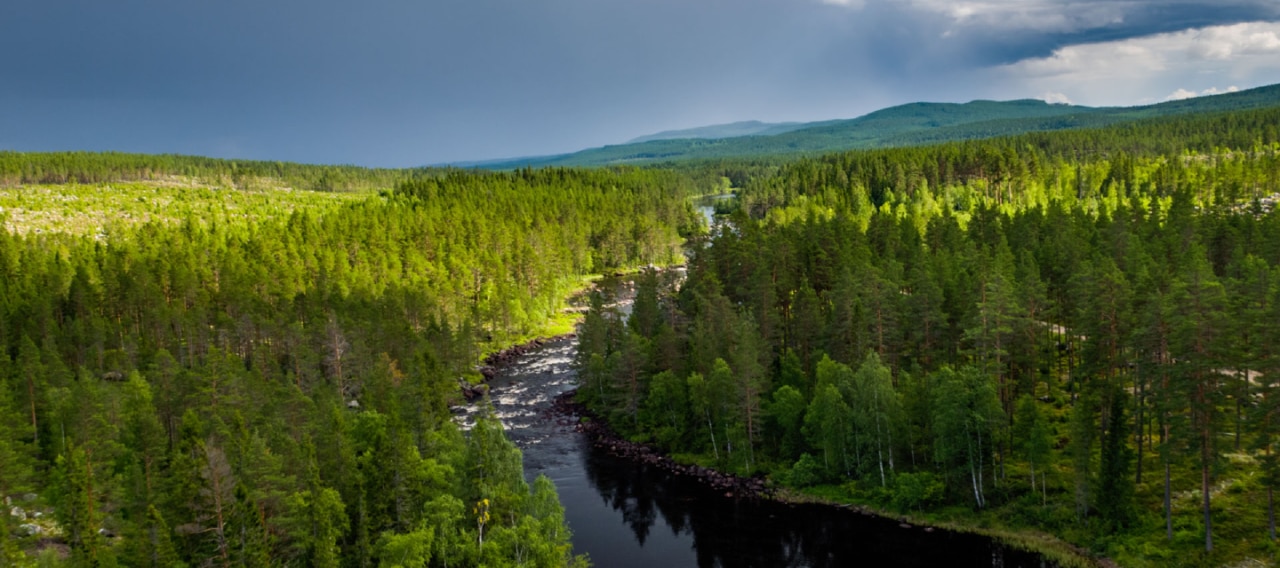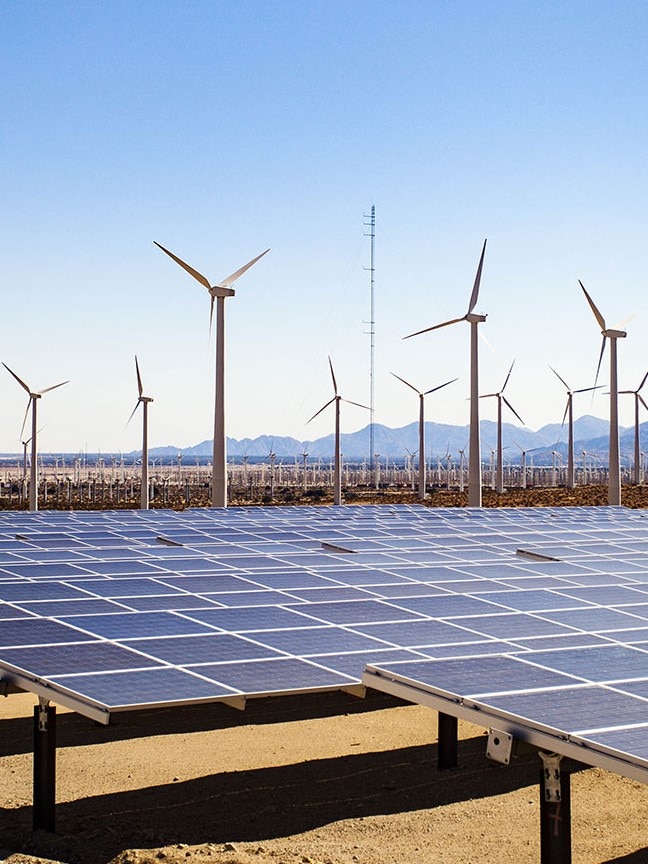As an active manager, and a fiduciary, we're focused on decarbonising our existing portfolio not only to manage the transition risks of climate change, but also to seize the opportunities presented by the energy transition.
105+ GW
green energy assets in development, construction or operation1
$A1.7b
invested, committed or arranged financing in MAM green energy assets2
~85%
MAM portfolio companies (as at Dec 2020) with Scope 1 and 2 net zero business plans established by 20223
For two decades Macquarie has worked in close partnership with stakeholders in the public and private sectors to support the energy transition and advance solutions to climate challenges.
Within MAM, as an active manager, and a fiduciary, we’re focused on decarbonising our existing portfolio not only to manage the physical and transition risks of climate change, but also to seize the opportunities presented by the energy transition. And, as an investor, we’re committed to finding and creating compelling climate solutions for our clients, portfolio companies and communities.
Learn more about Macquarie’s climate journey.
In December 2020, we announced a commitment to invest and manage our portfolio in line with global net zero emissions by 2040.
The implementation of our net zero commitment is inherently complex, and we are in the early stages of making progress on our goals. There have been significant developments in this area over the last three years, including new methodologies which were not available in 2020, along with a deeper understanding of the various pathways to net zero and their associated challenges across the sectors and asset classes in which we invest.
In light of these developments, we confirm our commitment to invest and manage our portfolio in line with global net zero scope 1 and 2 greenhouse gas (GHG) emissions by 2040, where we have control or significant influence.4 Where we do not have control or significant influence, such as in our managed portfolio of public securities, we will continue to support the goals of the Paris Agreement5 in a manner consistent with our client-guided fiduciary and regulatory responsibilities.
Over the near term, we will provide more detail on how we are implementing our net zero strategy across our various asset classes. We will also disclose further information on our interim targets, the assumptions we have made and the methodologies we are using.
- Learn more about our net zero commitment
- Listen to our 'Navigating to Net Zero' podcast series
- Find out what's involved in setting a net zero business plan.
4. MAM generally only has influence over scope 1 and 2 emissions. However, to the extent possible, in line with the Net Zero Asset Managers initiative guidance, MAM intends to support assets where it has control or significant influence to reduce their scope 3 emissions.
5. The Paris Agreement's central aim is to strengthen the global response to the threat of climate change by maintaining a global temperature rise this century well below 2°C above pre-industrial levels and to pursue efforts to limit the temperature increase even further to 1.5°C. The Intergovernmental Panel on Climate Change concluded the need for net zero emissions by 2050 to remain consistent with 1.5°C.
The scale of the issue at hand requires collaboration and partnerships. No one can reach net zero alone – no company, no sector, no country. In partnership with our portfolio companies and properties, we are making progress with our decarbonisation goals. But we still have some way to go.”
Kristina Kloberdanz
Chief Sustainability Officer, Macquarie Asset Management
Annual clean energy investment worldwide will need to almost triple from $US1.7 trillion in 2023 to $US4.6 trillion by 2030 to put the world on track for reaching net zero emissions by 20506. The world needs to scale up production of mature technologies like solar and wind as swiftly as possible to give communities sufficient access to clean electricity. Meanwhile, we must also support the commercialisation of emerging climate solutions and technologies that enable deeper decarbonisation.
In our private market businesses, we’re enabling clients and portfolio companies to scale their investment in renewable energy generation through our specialist developers. We’re also investing in the next phase of the energy transition, with portfolio companies developing grid-scale battery storage, biomethane projects and green hydrogen production. And in our public market businesses, we’re engaging with companies to understand and assess the commercial viability of their decarbonisation pathways and climate solutions.
Learn more about our specialist green investments teams
See how we measure our impact in the latest Progress Report.
There’s a symbiotic relationship between mature and emerging clean energy technologies. We are working across the full technology spectrum to offer clients, portfolio companies and partners exposure to a diverse set of climate solutions which can help them achieve their sustainability goals.”
Mark Dooley
Head of MAM Green Investments, Macquarie Asset Management
The role of natural assets in reaching net zero is critical – encompassing issues around air and water quality, food and fibre production, conservation, biodiversity, and carbon sequestration. This relationship demands careful consideration around how we meet the growing needs of communities, while protecting our natural systems and biodiversity.
With more than 4.7 million hectares of farmland7, our Private Markets’ portfolio provides potential for large-scale, cost-effective, nature-based carbon sequestration. We already have a variety of carbon sequestration projects under operation and development, and as environmental markets mature, we expect the size of these carbon abatement opportunities to grow significantly. Within our public markets businesses, we are engaging with investee companies on a range of biodiversity considerations, including pollution, waste management and resource efficiency.
Learn more about nature-based solutions and the evolution of agriculture
We are increasingly focused on the capacity of our landscapes to sustainably produce food and fibre, while making a meaningful contribution to the removal of carbon from the atmosphere through nature-based solutions.”
Elizabeth O’Leary
Chair of Agriculture and Natural Assets, Macquarie Asset Management
The world is already seeing widespread climate disruption, affecting the lives of billions of people, and we can expect additional severe climate impacts.8 As the custodian of critical transport, utilities and communications infrastructure, adaptation to these risks is a high priority.
Across our private markets portfolio companies, we are investing in more resilient power supplies, utilising predictive weather and climate forecasting to anticipate extreme weather events, and working closely with customers and local communities to help ensure their health and safety. Within our public markets businesses, we are investing in companies that provide products and services needed to adapt to a warming climate.
Learn more about our approach to climate adaptation and resilience
Investment in adaptation and resilience happens through proactive risk management, planning and good communication. We are increasingly able to benefit from technology – such as sensors, drones and geospatial systems – to improve early detection of potential risks and take proactive measures to reduce downtime of critical assets.”
Leigh Harrison
Head of Real Assets, Macquarie Asset Management
The circular economy is a key component of a sustainable energy transition. It aims to reduce net waste through recycling waste into carbon-neutral energy or products, alongside material recovery, repurpose and reuse. This is an area of past and future investment opportunity for our clients.
Within our private markets businesses, many of our waste portfolio companies around the world are collecting waste that would have otherwise gone to landfill and processing it towards reusable products. Meanwhile, other portfolio companies are encouraging more sustainable product use and reuse in their supply chains, such as in the telecommunications and real estate sectors.
Explore our work in action: Beauparc (UK).
Beyond reducing carbon emissions, we are seeing waste-to-resource businesses create secondary product streams along their value chain through processes that recycle and reuse waste. The circular economy has not only reoriented their business strategies, but also redefined their approach to value creation.”
Hani Zogheib
Head of Diversified Infrastructure, EMEA, Macquarie Asset Management
Recent insights
Contact us
Want to find out more about our approach to sustainability?
- As at 31 March 2023 on our balance sheet or under Macquarie management. Excludes lending and private credit funds. GW of green energy assets reflect 100% generating capacity of each asset, not the proportion owned/managed by Macquarie. Refer to the FY2023 Basis of Preparation for ESG Reporting for the definition of ‘green energy assets’.
- PwC has provided limited assurance over the total amount invested, committed or arranged by the Group in green energy assets in FY2023 ($A2.2 billion), as detailed in the PwC independent assurance report available within Macquarie’s FY2023 Basis of Preparation for ESG Reporting. MAM Private Markets portion of the total amount invested, committed or arranged is $A1.67 billion. Refer to the FY2023 Basis of Preparation for ESG Reporting for the definition of ‘green energy assets’.
- The percentage of MAM Private Markets’ infrastructure and agriculture portfolio companies with Board-approved net zero plans is calculated based on the number of portfolio companies (a) that were in MAM Private Markets’ portfolio at the time of its net zero commitment in December 2020 and (b) where MAM exercises control or significant influence.
- MAM generally only has influence over scope 1 and 2 emissions. However, to the extent possible, in line with the Net Zero Asset Managers initiative guidance, MAM intends to support assets where it has control or significant influence to reduce their scope 3 emissions.
- The Paris Agreement's central aim is to strengthen the global response to the threat of climate change by maintaining a global temperature rise this century well below 2°C above pre-industrial levels and to pursue efforts to limit the temperature increase even further to 1.5°C. The Intergovernmental Panel on Climate Change concluded the need for net zero emissions by 2050 to remain consistent with 1.5°C.
- IEA, World Energy Investment 2023, May 2023.
- As at 31 March 2023.
- IPCC, 2022: Climate Change 2022: Impacts, Adaptation, and Vulnerability. Contribution of Working Group II to the Sixth Assessment Report of the Intergovernmental Panel on Climate Change [H.-O. Pörtner, D.C. Roberts, M. Tignor, E.S. Poloczanska, K. Mintenbeck, A. Alegría, M. Craig, S. Langsdorf, S. Löschke, V. Möller, A. Okem, B. Rama (eds.)]. Cambridge University Press. Cambridge University Press, Cambridge, UK and New York, NY, USA, 3056 pp., doi:10.1017/9781009325844.
[2971101]
Sustainability at Macquarie Asset Management




